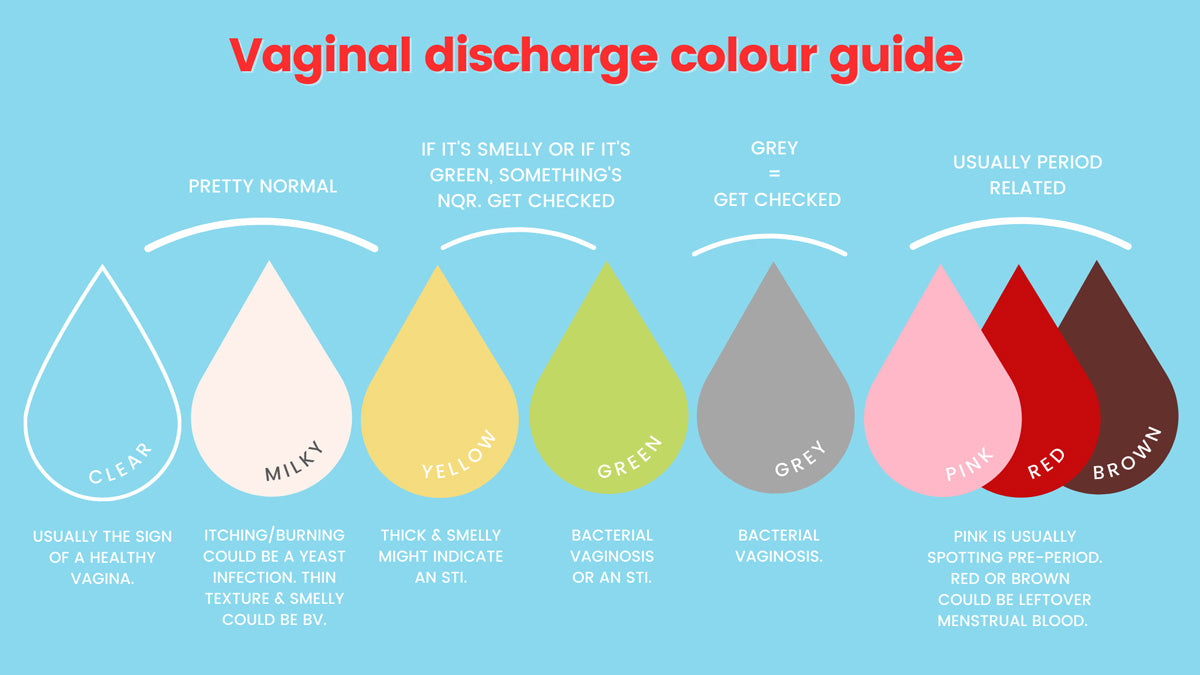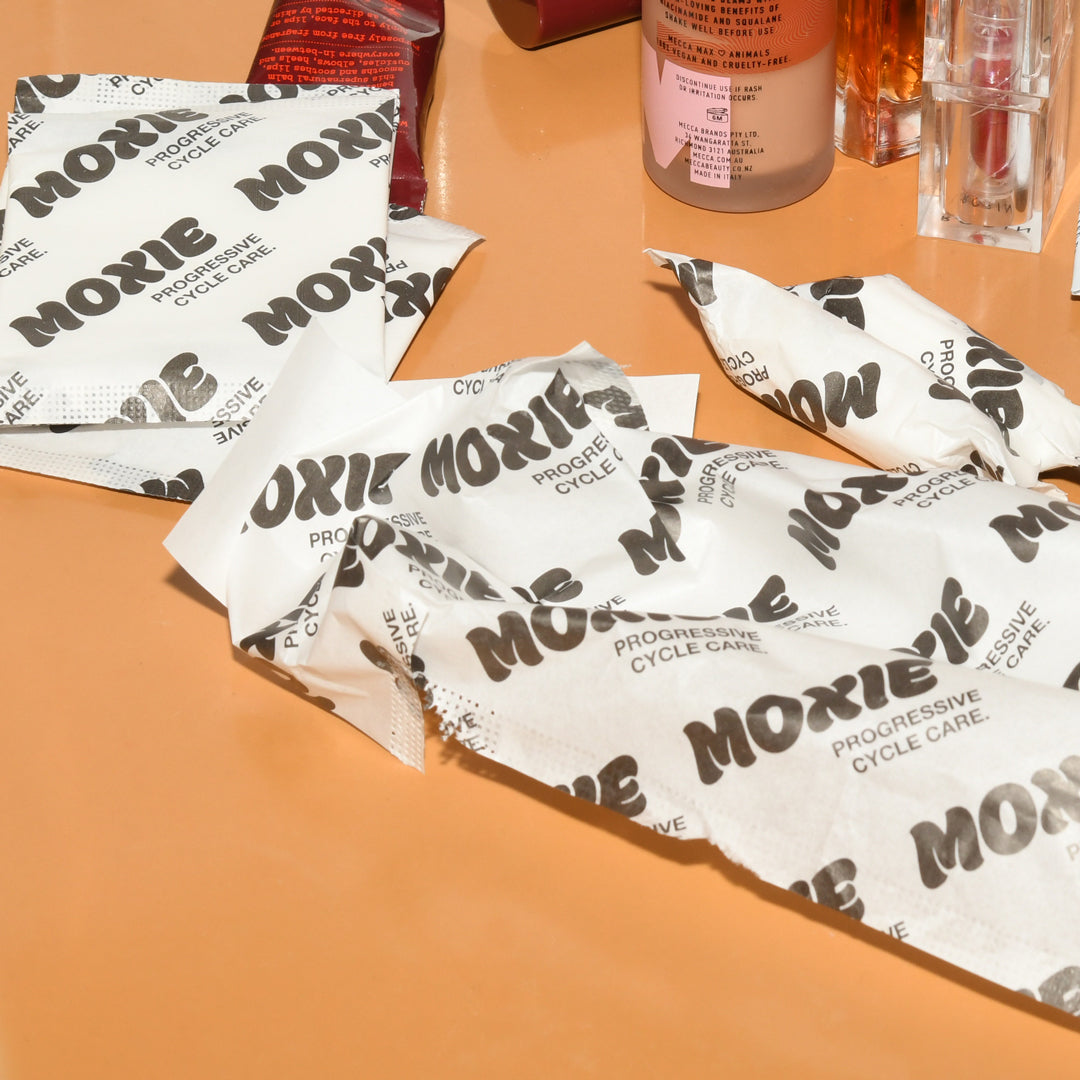What does my discharge mean?

WHAT IS VAGINAL DISCHARGE?
Vaginal discharge is a clear, white or off-white mucus-like fluid produced by the uterus, cervix and vagina. It can also sometimes be referred to as 'cervical fluid', though the correct medical term is 'leukorrhea'. It's main function is to help lubricate and clean the vagina to help keep it infection-free, by removing old cells and bacteria each day (so clever!). Vaginal discharge is excreted from, you guessed it: the vagina.
The texture and consistency of your vaginal/cervical discharge can vary, depending on where you're at in your menstrual cycle, or even at what stage of life. It may also vary in colour, though this may be a sign of bacteria and that it's time to get checked by your Doctor (we'll get into this a little later on).
WHO GETS DISCHARGE?
Pretty much everyone born with a vagina will experience discharge.
You will start noticing it around puberty, and you will get it before your period starts (it's usually a sign your period is around 6mths - 1year away, though it can be longer for some people).
You will have discharge throughout your life - you might have more at times (for example, during pregnancy your body might produce more of it) and as you age and experience menopause, you may have less.
WHAT ARE THE DIFFERENT TYPES OF DISCHARGE?
'Discharge' is a general umbrella term for secretions out of the vagina, and there can be various types: vaginal/cervical discharge, arousal discharge or fluid, and even menstrual flow, which is also considered a type of dicharge.
Let's focus more on the types of vaginal, or cervical discharge you might experience.
THIN/WATERY AND A BIT YELLOW
Pretty normal, and often a sign that your period is on the way. The yellow-ish tinge to this type of discharge is usually early period flow mixing with cervical mucus. If this discharge isn't accompanied by other symptoms (i.e. burning, itching or soreness from the vagina or around it) then it shouldn't be anything to worry about. Though if in doubt, get checked out.
WHITE OR MILKY, THICK AND STICKY
You'll notice this type most around the start of your menstrual cycle. This is totally normal.
CLEAR AND WATERY
Totally normal and can occur any time. Can also happen whilst you're exercising, or during puberty.
CLEAR AND STRETCHY
As above! Though this might indicate that you're ovulating.
THICK AND WHITE (LIKE COTTAGE CHEESE)
If accompanied with itchiness or any type of soreness around your vagina, this may be an indicator that you have thrush. Head to the Doctor, Moxette.
SMELLY
If your discharge has a foul or fishy smell to it, there's probably something going on down/in there that shouldn't be. This could be a sign of bacterial vaginosis and may need medical attention, so best to make an appointment with your GP ASAP.
If your vaginal discharge is any shade other than clear, white or milky, (see the colour chart, below) or smells unpleasant, this could be a sign of infection - time to see your Doc, Moxette.
WHAT DOES 'NORMAL' DISCHARGE LOOK LIKE?
'Normal' discharge is usually clear or milky, and will likely have a very subtle scent, though not an unpleasant one. If your discharge is any other colour, or smells a little off, something likely is a little - well, off, and a sign that you should make an appointment with your GP, ASAP.
WHAT DOES THE COLOUR OF MY DISCHARGE MEAN?
A change in the colour of your discharge can indicate a sign of bacterial infection, but did you know that sometimes, what you eat can affect its colour? So how do we know the difference? Here's you mini guide on what to look out for, and when to get checked, by colours:

CLEAR DISCHARGE
Nothing to see here, Moxettes. This is usually a sign that your vagina is self-cleaning itself as it should be (it's also probably a sign that you're ovulating - see below, in the menstrual cycle FAQ).
CREAM, WHITE OR MILKY DISCHARGE
Discharge in shades of creams and whites are generally nothing to worry about, unless you experience other symptoms with it like itching and burning along with a cottage cheese-like texture to your discharge (this could be a sign of a yeast infection) or an unpleasant smell and thinner texture, which may be a sign of Bacterial Vaginosis (BV).
If you're experiencing any of these additional symptoms, see a Doc.
YELLOW DISCHARGE
Yellow-ish discharge is actually quite common - though confusingly, when accompanied with certain symptoms, yellow discharge might be cause for concern. Here's what you need to know:
If your discharge is thin in texture, pale yellow in colour, and has little to no smell (or no unpleasant smell) then it's probably nothing to worry about.
If your discharge is yellow with no smell but thicker in texture, this could be an indication that your period is coming, or an early sign of pregnancy.
If your discharge is thick in texture, yellow and accompanied by an unpleasant smell and any itching or burning sensations, then it may indicate sign of a Sexually Transmitted Infection (STI) like gonorrhea, chlamydia or trichomoniasis.
GREEN DISCHARGE
Time to make an appointment with your Doctor, Moxette. Green vaginal discharge is a sure sign of bacterial infection like BV, or and STI like those mentioned above.
GREY DISCHARGE
Discharge that is any shade of grey indicates an unhealthy vagina and is usually a sign of BV. Don't stress - BV is commonly and usually easily treatable with antibiotics, prescribed by your GP.
PINK, RED OR BROWN DISCHARGE
These shades indicate that there is blood involved somehow.
Pink discharge is most commonly associated with spotting just before your period or even mid-cycle during ovulation, but can also be a sign of implantation bleeding early on in pregnancy. If you think you might be pregnant, take a pregnancy test (these are usually most effective after a missed period, but follow the instructions on pack or talk with a pharmacist/your doctor).
If your discharge is red, dark red or brown, you've either got your period (in which case, you have your period, not just vaginal discharge), are at the end of your period and there's a bit of menstrual blood leftover that's mixing in with your discharge, or it could be a sign of a cervical infection. In rarer instances, it may be a symptom of cervical cancer. If you're concerned, always get checked.
HOW MUCH DISCHARGE IS CONSIDERED 'NORMAL'?
Generally speaking, it's considered fairly normal to have around 1/2 - 1 teaspoon of vaginal discharge a day, though this will vary from person to person. Some people will experience vaginal discharge every day (the texture and consistency will likely change throughout your cycle, if you're a menstruating person - more on this further on) and others will have it less frequently.
It's important to understand what a 'normal' amount looks like for you so that you can notice any changes over time. If at any point you're experiencing more or less discharge than usual, check in with your Doc.
WHY DO I HAVE DISCHARGE EVERY DAY?
This is normal, Moxette, and your body's way of keeping your vagina clean and infection free, by removing any old cells and bacteria. You might notice you have more discharge on some days more than others, and sometimes you might not have any at all - this can be totally normal too, depending on where you're at in your menstrual cycle.
WHY DO I HAVE NO DISCHARGE?
Some medications can affect the amount of cervical fluid you have, as can the phase of the menstrual cycle you're in, and your stage of life. You might have more during pregnancy, caused by an increase in hormone levels and your vaginas way of helping prevent bacteria making its way up into the womb. As you get older, like into menopausal years, your body will produce less discharge, as your estrogen levels decline.
See your doc if you're of menstruating age and not experiencing discharge at all, or are worried in any way.
WHY DOES MY VAGINAL DISCHARGE CHANGE THROUGHOUT MY MENSTRUAL CYCLE?
Your menstrual cycle is more than just a period - as you may have learned from this piece posted on the blog a few weeks ago, it's a complex series of events that go on in your body to prepare it for a potential pregnancy. If pregnancy doesn't occur, you'll likey experience a menstrual period (if you've reached puberty and are within your menstruating years); but this is just the first phase!
Let's look at how your vaginal discharge changes with the four phases of your menstrual cycle (please note: where we refer to 'roughly', below, this is because some people have longer or shorter menstrual cycles - this info is based on an average 28 day cycle. This guide, and the texture of your discharge might even help you to determine in what phase you're in of yours!):
PHASE 1: MENSTRUATION (roughly days 1 - 5)
During this phase, there's little discharge (if any). You'll notice your menstrual flow more than anything, which is a mix of blood, cervical fluid and tissue from the lining of the uterus (the endometrium).
TL;DR Period blood, no discharge.
PHASE 2: FOLLICULAR PHASE (roughly days 6 - 12)
Your cervix will start to produce more mucus as your estrogen levels rise, making your discharge thick, white, and milky. This is your body's way of telling you it's not time to get pregnant yet (though it's not impossible, as sperm can live up to five days), as the thickness and texture of your discharge is designed to block sperm trying to reach your uterus.
If you notice any spotting during this phase, it's most likely leftover blood from your period. If you're concerned, check in with your Doc.
TL;DR Discharge is thick, white and milky.
PHASE 3: OVULATION (roughly days 13 - 14)
You produce the most discharge the most during this phase, and so this is probably when you'll notice it most, too. It's texture is more like egg-whites: watery and slippery, and is designed to help a sperm reach the egg for a potential pregnancy.
TL;DR Lots of discharge (the most). Clear and slippery.
PHASE 4: LUTEAL PHASE (roughly days 15 - 28)
Discharge becomes thicker as your progesterone levels rise, and may even become completely absent during this phase, as sperm can't swim in these conditions; nor can bacteria make their way into the uterus whilst a fertilised egg is implanting (that is, if pregnancy is occuring. If it doesn't, the menstrual cycle starts again!).
TL;DR Discharge is really thick, or completely absent.
WHY DOES MY DISCHARGE 'BLEACH' MY UNDIES?
This is not at all uncommon Moxette, and despite it being a bit pesky if you've 'ruined' a few too many pairs of your favourite undies (note: it tends to show more on the darker colours), it's generally nothing to worry about. It's caused by the acidity in your discharge and is actually considered to be one of the signs of a healthy, happy vagina!
MY DISCHARGE DRIES YELLOW AND CRUSTY ON MY UNDIES, IS THAT NORMAL?
Your discharge will most likely exit your vagina in a more liquid state, but at times it might change colour slightly and appear a little different on your undies as it dries - like, slightly more white, or even a tad yellow. Don't worry, that's usually pretty normal! Keep and eye out for any other unusual symptoms, but just keep maintaining good intimate health as you normally wouldl, change your undies regularly and see your doctor if anything seems out of whack.
IS IT DISCHARGE, OR AM I WET?
'Wet' is a more colloquial term for what's otherwise known as 'arousal fluid'. Whilst still technically a type of vaginal discharge, arousal fluid differs from cervical discharge in texture (arousal fluid is clear, slippery and wet) and is caused by the body's physiological and psychological response to sexual stimulation, in preparation for potential sexual activity. It's function is to lubricate the vaginal canal for easier and more comfortable intercourse.
You might notice some other signs of arousal - like swelling of the clitoris and labia minora (caused by increased blood flow to the area) - which is a sign that you're experiencing arousal fluid rather than discharge.
WHEN TO GET CHECKED
Vaginal discharge is usually nothing to worry about (see above for what is considered pretty 'normal'), but if you notice any of the following, make an appointment to see your Doctor:
- any change in colour, smell or texture (again, not in line with what's considered 'normal')
- you feel itchy, a burning sensation or any kind of soreness in or arround your vagina or vulva
- you feel burning or any pain when passing urine
- you feel any kind of abnormal pelvic pain
- your experiencing more discharge than usual
- bleeding in-between periods or during/after penetrative (vaginal) sex
If you're ever unsure about anything at all to do with your intmate health (or health in general), please check in with a trusted health practitioner.



